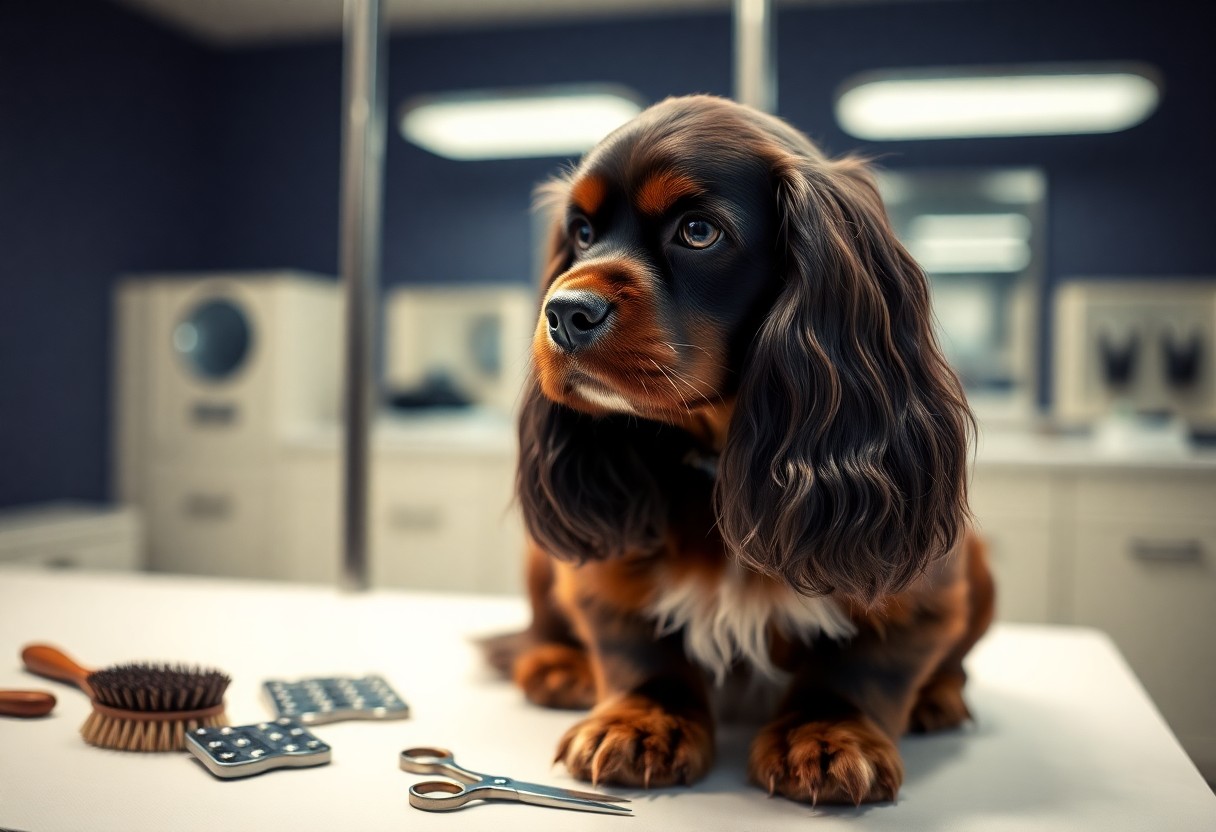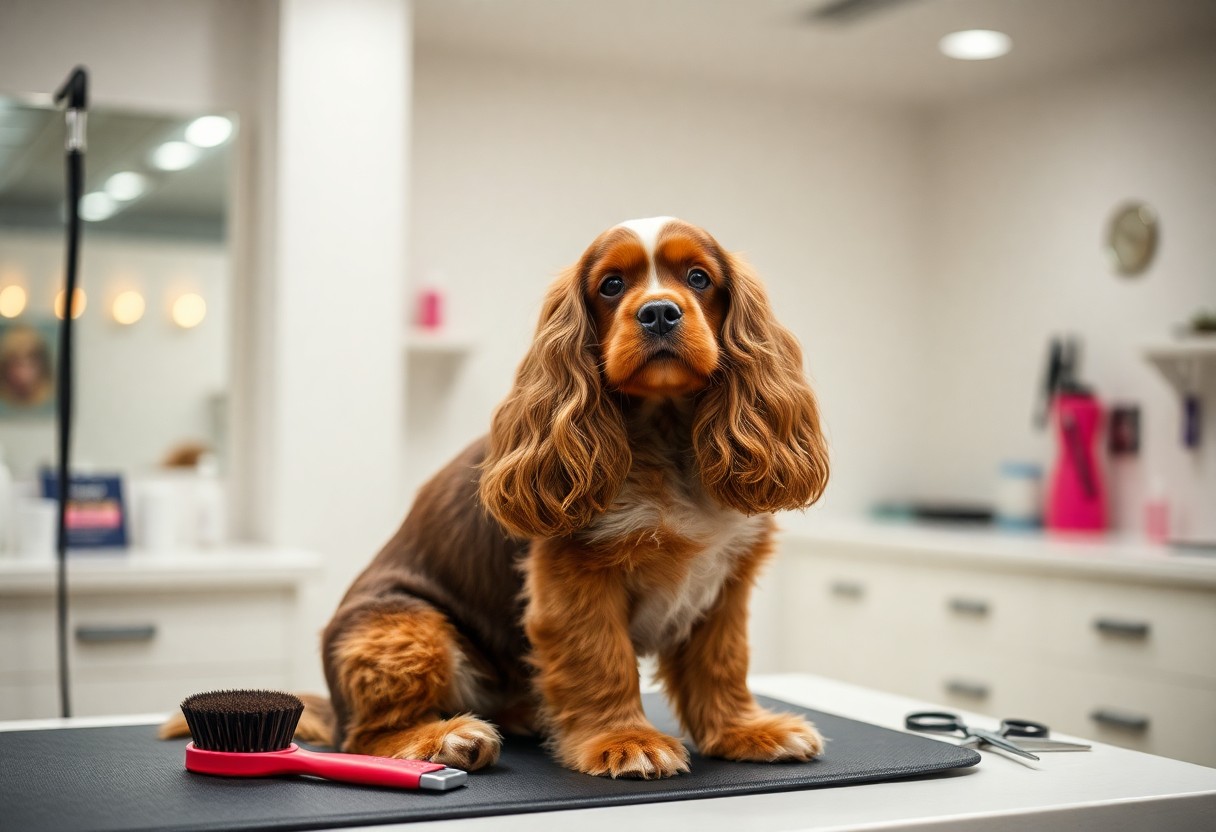This guide will help you understand your Cocker Spaniel’s grooming needs to maintain their beautiful coat. Regular grooming not only keeps their coat healthy and shiny but also helps prevent matting and skin issues. You should dedicate time to brushing, bathing, and trimming to ensure your furry friend looks and feels their best. For tips on grooming techniques, Learn How to Cut Cocker Spaniel Hair and become a pro at caring for your pet’s special needs.
Key Takeaways:
- Regular brushing is necessary to prevent matting and tangles in Cocker Spaniel’s long, silky coat.
- Bathing should be done every 4 to 6 weeks, using a gentle dog shampoo to maintain coat health and cleanliness.
- Pay attention to ear care, as Cocker Spaniels are prone to ear infections; weekly checks and cleaning are recommended.
- Trim the fur around the eyes, ears, and paws to keep them tidy and reduce the risk of irritation or infection.
- Professional grooming every 6 to 8 weeks can help maintain the coat’s shape and manage shedding effectively.
- Hydration is vital for skin health, so ensure your dog has access to fresh water daily.
- A balanced diet rich in omega fatty acids can contribute to a shiny, healthy coat and overall skin health.
Understanding Cocker Spaniel Coat Types
A Cocker Spaniel’s coat can vary significantly, which requires you to tailor your grooming routine accordingly. Here’s a breakdown of the common coat types:
| Coat Type | Description |
|---|---|
| American Cocker Spaniel | Shorter, denser, and wavy |
| English Cocker Spaniel | Medium length, flat, and silky |
| Wavy Coat | Soft and gentle waves |
| Straight Coat | Very smooth and sleek |
| Curly Coat | Tight curls that require regular brushing |
After understanding the variations, you can better address your Cocker Spaniel’s specific grooming needs.
Factors Affecting Coat Health
Assuming you want a vibrant coat for your Cocker Spaniel, several factors influence its health:
- Diet – A balanced diet is crucial for a healthy coat.
- Genetics – The coat type may depend on your dog’s lineage.
- Age – Older dogs may have different grooming needs.
- Environment – Climate can greatly affect coat condition.
- Grooming routine – Regular grooming maintains coat integrity.
Though you consider these factors, only consistent care can ensure your Cocker Spaniel’s coat remains healthy and vibrant.
Importance of Regular Grooming
Assuming you want to keep your Cocker Spaniel looking its best, regular grooming is vital. Regular grooming helps to prevent tangles and matting, which can lead to discomfort or skin issues. You should also check for irritations or signs of parasites during grooming sessions.
Types of grooming you need to perform include brushing to remove loose fur and dirt, bathing to keep their coat clean and free from odor, and trimming to maintain a healthy length. Consistent grooming not only keeps your Cocker Spaniel’s coat looking its best but also enhances your bond with them. Additionally, neglecting grooming can lead to serious skin problems and discomfort for your pet.
Essential Grooming Tools
Assuming you want to keep your Cocker Spaniel’s coat healthy and beautiful, investing in the right grooming tools is vital. These tools not only aid in maintaining their coat but also enhance your pet’s overall well-being. A quality brush, comb, and grooming mitt are just a few items that can make grooming sessions more efficient and enjoyable for both you and your furry friend.
How-to Choose the Right Brush
There’s a wide variety of brushes available, and selecting the right one for your Cocker Spaniel’s coat type is important. Opt for a pin brush with a long handle to effortlessly navigate through their thick fur and undercoat. A slicker brush can also be beneficial for eliminating tangles and mats, ensuring your dog stays healthy and comfortable.
Tips for Bathing Your Cocker Spaniel
For an effective bathing experience, you should follow some key steps to ensure your Cocker Spaniel is clean and safe:
- Use a gentle shampoo designed for dogs to avoid skin irritation.
- Brush your dog before bathing to remove loose hair and tangles.
- Ensure water temperature is lukewarm for your dog’s comfort.
Knowing how to properly bathe your Cocker Spaniel will not only keep their coat clean but also contribute to a healthy skin barrier, providing a soothing bathing routine.
Understanding the bathing process for your Cocker Spaniel can significantly impact their comfort and cleanliness. Before you start, always ensure you have everything needed within reach, including a strong grip on the dog, to avoid any slips or accidents. Taking extra care during the bathing process can promote a positive experience for you both.
- Use a non-slip mat to help your dog stay stable.
- Rinse thoroughly to ensure no shampoo residue remains.
- Dry properly with a towel or dog dryer, avoiding hot air directly on the skin.
Knowing these vital tips for a safe and thorough bathing session will help maintain your Cocker Spaniel’s readiness for the world.
Brushing Techniques
Not brushing your Cocker Spaniel regularly can lead to a dull and unhealthy coat. Utilize appropriate brushing techniques to maintain their fur and keep it free of knots and tangles. For comprehensive tips, check out Coat care tips : r/cockerspaniel to learn from fellow pet owners on how to keep your dog’s coat in top shape.
How-to Brush for Optimal Coat Care
On a routine schedule, gently brush your Cocker Spaniel’s coat using a slicker brush or a pin brush. Start at the roots, working your way to the tips to remove dirt and loose hair effectively. Pay special attention to areas behind the ears, under the legs, and on the belly where tangles often occur.
Tips for Managing Matting and Tangles
Matting can be a frustrating issue for Cocker Spaniels. To effectively manage and reduce tangles, follow these key tips:
- Brush your dog’s coat daily to prevent matting.
- Keep their coats clean and well-hydrated with quality shampoo and conditioner.
- Use detangling sprays for stubborn knots.
Knowing how to approach matting can make grooming a positive experience for both you and your dog.
Another effective strategy to manage matting is to regularly inspect and address small tangles before they develop into bigger problems. Here are additional tips you can use:
- Use your fingers to separate the hair before using a brush.
- Always work on the tangles when your dog is calm to avoid discomfort.
- If necessary, consult a professional groomer for severe cases.
Knowing these tips can help you maintain a beautiful, healthy coat for your Cocker Spaniel.
Grooming Frequency and Schedule
Your Cocker Spaniel’s grooming frequency is vital for maintaining a shiny, healthy coat. Typically, these dogs require grooming every 4 to 8 weeks to prevent matting and maintain their coat’s luster. Regular grooming not only helps with their appearance but also allows you to check for skin issues, parasites, and other health concerns. Creating a consistent schedule can make this process easier and more effective.
How-to Determine the Ideal Grooming Schedule
Grooming your Cocker Spaniel involves assessing their coat type and condition. Factors such as length, texture, and activity level can influence how often you need to groom them. Monitoring these details will help determine the ideal grooming routine for your furry friend.
Factors Influencing Grooming Needs
Schedule your Cocker Spaniel’s grooming based on several key factors:
- Coat length: Longer coats require more frequent grooming.
- Activity level: Active dogs may need extra attention due to dirt and tangles.
- Seasonal changes: Shedding may increase during certain times of the year.
- Health conditions: Certain medical issues can impact grooming needs.
Recognizing these factors can help you establish a personalized grooming plan that keeps your Cocker Spaniel comfortable and healthy.
For instance, if your dog has a exceptionally thick coat, you might find yourself grooming more often, especially during shedding season when loose hair can easily mat. On the other hand, a Cocker Spaniel with a shorter coat may require less frequent grooming. Additionally, if your dog loves to play outside or rolls in dirt, this could increase the grooming needs substantially. Other important factors like age and activity level also play a role in determining an effective schedule. Recognizing these aspects ensures you maintain your dog’s coat and skin health effectively.
Nail Care and Ear Cleaning
Unlike many breeds, Cocker Spaniels have unique grooming needs that include regular nail care and ear cleaning to maintain their overall health. Due to their long ears, they are prone to ear infections, while their nails can become overgrown if not properly trimmed. Keeping both in check will ensure your furry friend stays comfortable and healthy.
How-to Maintain Healthy Nails
Clearly, regular nail trimming is necessary for your Cocker Spaniel. Start by using a high-quality dog nail trimmer and work gently, avoiding the quick to prevent bleeding. Aim to trim your dog’s nails every 3-4 weeks for optimal health and comfort.
Tips for Clean Ears and Preventing Infections
While keeping your Cocker Spaniel’s ears clean is vital to avoid infections, proper techniques must be followed. Here are some tips:
- Use a vet-approved ear cleaner to gently clean the inner ear without causing harm.
- Regularly inspect for wax buildup or signs of infection such as redness or odor.
- Wipe the outer ear with a damp cloth to remove debris.
- Avoid using cotton swabs inside your dog’s ear canal, as this can push dirt further in.
This will help you maintain your pet’s ear health.
Howto ensure you effectively clean your Cocker Spaniel’s ears involves establishing a routine you can follow. Regular cleanings, ideally every 1-2 weeks, will prevent excess wax and reduce infection risk. When cleaning, look for signs of redness or foul odors, which can indicate infection or irritation. Also, keep the hair around the ear canal trimmed to promote airflow and reduce moisture buildup. Here are crucial factors to keep in mind:
- Choose a dog-friendly ear cleaner that is gentle and effective.
- Keep the ears dry to discourage bacteria growth.
- Take your Cocker Spaniel to the vet if you notice persistent signs of discomfort or infection.
This may prevent serious health issues down the line.
Professional Grooming Services
After a thorough home grooming routine, you may consider seeking out professional grooming services for your Cocker Spaniel. These experts possess the right tools and experience to manage your dog’s unique coat requirements, from trimming to styling. Regular professional grooming can help maintain a healthy coat and address any underlying skin issues, ensuring your furry friend looks their best.
How to Find the Right Groomer for Your Cocker Spaniel
Spaniel owners must take time to research potential groomers. Look for experienced professionals who specialize in Cocker Spaniels and have a solid reputation in your area. Online reviews and community recommendations can help you find a groomer who meets your pet’s specific needs.
Tips for Assessing Groomer Quality
One effective way to determine groomer quality is by assessing their facility and interactions with pets. Consider these factors:
- Cleanliness of the grooming facility
- Staff experience with Cocker Spaniels
- Techniques used during grooming
- Comfort level of your Spaniel in their care
Perceiving the environment your dog will be in is vital to ensuring their overall grooming experience is positive.
Understanding the quality of a groomer goes beyond mere appearances; it’s about their ability to handle your Spaniel with care and expertise. Consider the following:
- Groomer communication regarding services offered
- Monitoring of your pet’s behavior
- Knowledge of Cocker Spaniel grooming specific needs
- Use of quality products during grooming
Perceiving care in these aspects can ultimately lead to a better grooming experience for your beloved Spaniel.
Final Words
Conclusively, keeping your Cocker Spaniel’s coat healthy requires regular grooming, which includes brushing several times a week, bathing as needed, and professional grooming sessions every couple of months. Pay special attention to their ears, nails, and underbelly to prevent matting and skin issues. By establishing a consistent grooming routine, you help maintain a shiny, healthy coat and strengthen your bond with your pet, ensuring they feel comfortable and valued.
FAQ
Q: How often should I groom my Cocker Spaniel?
A: Cocker Spaniels require regular grooming, ideally every 4 to 6 weeks. This frequency helps to manage their long, dense coats and keeps them looking tidy. Additionally, regular grooming helps to prevent matting and allows for an easier cleaning process.
Q: What tools are best for grooming a Cocker Spaniel?
A: Essential grooming tools for a Cocker Spaniel include a slicker brush for detangling and removing loose hair, a comb for fine-tuning mat removal, and a pair of grooming scissors for trimming around sensitive areas like the ears and paws. A portable vacuum or grooming mitt can help manage shedding, while nail clippers and ear cleaning solution are also important for overall hygiene.
Q: How do I prevent matting in my Cocker Spaniel’s coat?
A: To prevent matting, it’s advisable to brush your Cocker Spaniel at least two to three times a week. Pay special attention to areas prone to tangles, such as behind the ears and under the legs. Regular baths using appropriate dog shampoos and conditioners can also help maintain coat health and reduce matting. In addition, visiting a professional groomer every few months can aid in keeping your dog’s coat in top shape.
Q: What is the best way to bathe my Cocker Spaniel?
A: When bathing your Cocker Spaniel, use lukewarm water and a gentle, dog-specific shampoo. Wet their coat thoroughly, apply the shampoo, and massage it into the coat while avoiding the eyes and ears. Rinse well to remove all shampoo residue, then apply a conditioner to help detangle the coat. Make sure to dry your dog thoroughly afterward, either by towel-drying or using a low-heat dog dryer, to prevent moisture from accumulating, particularly around the ears.
Q: How do I care for my Cocker Spaniel’s ears?
A: Cocker Spaniels are prone to ear infections due to their long and floppy ears. Clean their ears regularly using a vet-recommended ear cleaning solution. Gently wipe the visible part of the ear flap and the ear canal without inserting anything too deeply. This helps remove excess wax and dirt. Additionally, keeping their ears dry after baths and maintaining proper grooming around the ears can contribute to ear health.
Q: Should I trim my Cocker Spaniel’s coat, and if so, how?
A: Yes, trimming is an important part of grooming for a Cocker Spaniel. Around every 6 to 8 weeks, take your dog to a professional groomer for a proper trim, which often includes shaping the body and feet and cleaning up the fur around the eyes and ears. At home, you can use grooming scissors to trim any excessively long or matted areas, but be cautious and use blunt-ended scissors to avoid any accidents.
Q: What dietary considerations help maintain a healthy coat for my Cocker Spaniel?
A: A balanced diet plays a significant role in keeping your Cocker Spaniel’s coat healthy. Look for high-quality dog food that contains omega fatty acids, which promote a shiny and healthy coat. Supplements such as fish oil can also be beneficial. Ensure your dog stays well-hydrated as proper hydration is necessary for skin and coat health. Consulting with your veterinarian can help you determine the best dietary options for your pet’s specific needs.


